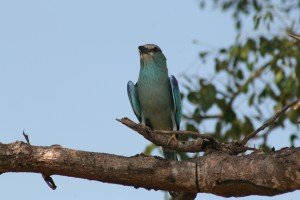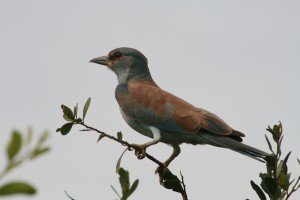Crocodile Bridge to Lower Sabie
The open savanna grassland between Crocodile Bridge and Lower Sabie not only provides plenty of game on the sweetveld, pan-dotted basaltic plains, but many of the typical “bushveld” birds of Kruger National Park.
Arriving at Crocodile Bridge at mid-morning in March almost guarantees you a hot welcome and so it was that, upon my arrival from Mlawula in Swaziland, I entered one of the southernmost gates of Kruger in sweltering 35° heat.
Crocodile Bridge is acknowledged as one of the hottest, most humid places in South Africa and arriving towards mid-day meant most birds were keeping quiet trying to conserve energy.
But just two kilometres from the entrance gate there are two significant spots that provide reward.
The first is the Gezantfombi Dam (more on that later) and the second is the turnoff for the Nhlowa Road (S28), one of the best birding drives in Kruger Park, particularly in late summer when the relatively water-impervious basalt allows numerous pans to survive around the stunted Knob-thorn and Marula trees.
Turning east on to the Nhlowa Road, towards the Lebombo Mountains, both Lilacbreasted and European Rollers were quickly seen, followed by another pleasing migrant in the Lesser Grey Shrike.
Most of the typical Bushveld birds were all there, with the long grass and numerous perches proving ideal habitat for Shrikes, which included Redbacked and Longtailed as well as the Lesser Grey.
Sabota Lark, Yellowbilled and Grey Hornbill and Arrowmarked Babbler were all there too.
After travelling 17 of the 24km towards Lower Sabie, you reach the Ntandanyathi Hide, a spacious, solid wooden structure that overlooks a section of the Nhlowa River.
Three Bushveld beauties were waiting there for me in Woodland Kingfisher, Greenbacked Heron and Crested Barbet.
In temperatures around 35°, birding around water is one of the better options and Gezantfombi Dam had earlier produced European Bee-Eater, Redbilled Buffalo Weaver, Common Scimitarbill and Cardinal Woodpecker, while crossing into Kruger over the Crocodile River bridge had thrown up a Redfaced Cisticola, locally common and always good to see, as well as Southern Red Bishop and Brownhooded Kingfisher.
The thorn trees around the parking lot where you complete the formalities of getting into Kruger had some friendly Blue Waxbill, tame Southern Greyheaded Sparrows and, surprisingly, a Steelblue Widowfinch, which is an uncommon resident in the park.
Between the gate and Gezantfombi Dam, one gets a taste of the thick thorn thicket known as Gomondwane Bush that characterises the tar road between Crocodile Bridge and Lower Sabie, and this is prime habitat for the Whitecrowned Shrike, another localised bird, which was sharing a tree with the ubiquitous Rattling Cisticola.
A pod of Hippopotamus was keeping cool in Gezantfombi Dam, while Elephant, Plains Zebra, Greater Kudu, Giraffe, Waterbuck and Slender Mongoose were all spotted along the open grassland savanna of the S28.
Nearing the tar road, and with the temperature now up to 37°, Marabou Stork were soaring on the thermals and there was also a Brown Snake Eagle flying about. Fantailed Cisticola were chip-chip-chipping at lower levels above the grassland.
All that hot air had to lead to something and, sure enough, a huge storm hit while I was setting up camp at Lower Sabie. Trying to hammer your tent pegs into the concrete-like hard ground of the badly redesigned campsite while a deluge is falling from the heavens is not the ideal way to end your first day of birding in Kruger Park, but it could not detract from the thrill of being back in the bushveld.
Sightings list
Southern Red Bishop
Redfaced Cisticola
Brownhooded Kingfisher
Blue Waxbill
Southern Greyheaded Sparrow
Steelblue Widowfinch
Impala
Blue Wildebeest
Whitebacked Vulture
European Swallow
Whitecrowned Shrike
Rattling Cisticola
Burchell’s Starling
Cape Turtle Dove
European Bee-Eater
Forktailed Drongo
Hippopotamus
Blacksmith Plover
Egyptian Goose
Redbilled Buffalo Weaver
Common Scimitarbill
Cardinal Woodpecker
Lilacbreasted Roller
European Roller
Redbilled Quelea
Elephant
Lesser Grey Shrike
Sabota Lark
Redbacked Shrike
Yellowbilled Hornbill
Longtailed Shrike
Arrowmarked Babbler
Plains Zebra
Greater Kudu
Giraffe
Grey Hornbill
Waterbuck
Grassveld Pipit
Woodland Kingfisher
Greenbacked Heron
Crested Barbet
Spotted Flycatcher
Glossy Starling
Marabou Stork
Slender Mongoose
Brown Snake Eagle
Fantailed Cisticola
Grey Lourie
Laughing Dove

